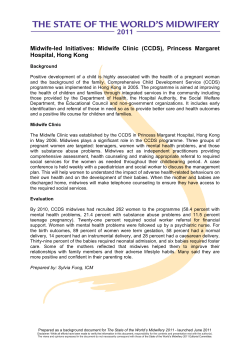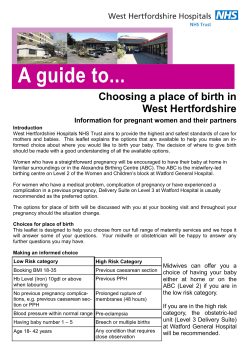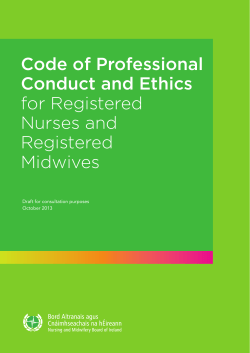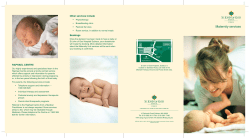
Standards for the preparation of supervisors of midwives 1
Standards for the preparation of supervisors of midwives 1 Standards for the preparation of supervisors of midwives Section 1 - Introduction 1 The Nursing and Midwifery Council (NMC) is the UK regulatory body for nurses and midwives. Its primary aim is to protect the public. Statutory supervision of midwives supports protection of the public by improving standards of midwifery practice and promoting best practice thereby improving outcomes for women. 2 The Nursing and Midwifery Order 2001(The Order) 1 requires the Council ‘to establish from time to time standards of education, training, conduct and performance for nurses and midwives and to ensure the maintenance of those standards’ (Article 3 (2)). The Order also provides for the Council to make rules to regulate the practice of midwifery and the supervision of midwives. 3 These rules and their related guidance are contained within the Midwives rules and standards (NMC, 2012) 2. The rules and standards prescribe the qualifications of those that may be appointed as a supervisor of midwives. They also require those midwives wishing to become supervisors of midwives to undertake courses of instruction to ensure they have the competencies necessary to undertake this role. 4 This programme of preparation has been developed for the purpose of preparing those midwives, who upon successful completion, intend to seek appointment as a supervisor of midwives. Entry onto the programme therefore, will require the midwife to undergo the relevant local supervising authority’s selection process. 5 Successful completion of the programme will be notified to the NMC by the Approved Education Institution (AEI) and appointment will be notified to the NMC by the LSA so that this can be noted against the midwife’s entry on the Register. 6 Statutory supervision of midwives is a UK requirement. However, it is acknowledged that it is undertaken in country and region specific contexts. It is essential for the local supervising authority to provide the necessary information relevant to the country or region to enable the supervisor of midwives to undertake the role effectively. 7 The standards for supervisors of midwives in Section 2 underpin the principles of statutory supervision of midwives within the context of the full scope and range of midwifery practice. Whilst undertaking the preparation of supervisor of midwives programme, midwives will be required to demonstrate they are proficient in all the competencies through theoretical and practical assessment. Following programme completion, these are benchmark competencies which must be maintained and against which a supervisor of midwives performance in practice can be measured. 1 2 SI 2002/253 SI 2012/3025 2 Standards for the preparation of supervisors of midwives 8 9 They are grouped into the following domains: 8.1 Professional values 8.2 Communication and interpersonal skills 8.3 Supervision in practice and decision-making 8.4 Leadership and team working The requirements of AEI’s wishing to provide programmes for which the NMC sets standards are contained within the Quality assurance framework, For nursing and midwifery education and local supervising authorities for midwifery Annexe 1 Requirements of approved education institutions (NMC, 2013). The requirements for education providers wishing to provide the preparation programme therefore assume that these generic requirements have been met. Section 3 sets out the specific education standards for the delivery of the preparation of supervisor of midwives programme by AEIs. Section 2 - Standards for supervisors of midwives Domain 1: Professional values Supervisors of midwives must: 1 Demonstrate an understanding of the statutory framework for the supervision of midwives and the role of the NMC and the LSA in protecting the public. 2 Demonstrate an understanding of, and comply with, the NMC standards, guidance and related information in their practice as a supervisor of midwives, in particular The code: Standards of conduct, performance and ethics for nurses and midwives (NMC, 2008), the Midwives rules and standards (NMC, 2012) and LSA guidelines on the supervision of midwives. 3 Demonstrate an understanding of the role of a supervisor of midwives including their role in providing support and guidance to women who access maternity services. 4 Demonstrate the ability to support midwives to maintain their fitness to practise and provide safe and evidence-based care. Domain 2: Communication and interpersonal skills Supervisors of midwives must: 1 Support and work collaboratively with midwives working with complex ethical, legal and professional issues. 2 Work in partnership with women and create opportunities for women to engage actively with and influence maternity service provision. 3 Standards for the preparation of supervisors of midwives 3 Support and work collaboratively with supervisor of midwives colleagues and members of multidisciplinary and governance teams to improve standards of care and ensure a safe service to women and their families. 4 Demonstrate the ability to engage with a wide variety of individuals, groups, agencies and organisations at local and national levels. 5 Recognise when people are anxious or in distress and respond appropriately so as to promote their wellbeing, personal safety and resolve conflict. 6 Use effective communication strategies and influencing skills to achieve desired outcomes, respecting the dignity and human rights of all concerned and know when to consult a third party and make referrals for advocacy, mediation or arbitration. Domain 3: Supervision in practice and decision-making Supervisors of midwives must: 1 Demonstrate an understanding of statutory supervision within the context of local governance policies and procedures. 2 Contribute to the development and monitoring of NMC standards and LSA guidelines in relation to the supervision of midwives. 3 Contribute to the development and operation of local frameworks that will enable student midwives to have access to a supervisor of midwives. 4 Demonstrate the ability to source information on evidence-based practice to support effective strategy and service development in relation to the supervision of midwives and midwifery practice. 5 Use appropriate strategies to support midwives to maximise their potential in practice. 6 Investigate or escalate concerns relating to midwifery practice as set out in the Midwives rules and standards (NMC, 2012). 7 Operate in a way that takes account of all equality and diversity issues, ensuring a fair, honest and transparent approach to the supervision of midwives. 8 Provide additional advice and support to women who are experiencing difficulty in achieving their care choices. Domain 4: Leadership and team working Supervisors of midwives must: 1 Act as a role model, apply best practice in motivation and provide visible leadership in the workplace. 2 Develop multidisciplinary team working which encourages mutual respect and values the contribution of all parties. 4 Standards for the preparation of supervisors of midwives 3 Be self aware, recognising own values, principles and assumptions. 4 Undertake continuing professional development in the supervision of midwives. 5 Appraise and modify performance as a supervisor of midwives by learning from experience, through feedback, reflection and evaluation. 6 Develop an understanding of the strategic and political factors which may influence the provision of maternity services. 7 Actively listen and provide support to women who raise concerns in relation to the care they have received and, work in partnership with members of the multidisciplinary and governance teams to investigate and respond appropriately and in a timely manner to address these concerns. Section 3 - Education standards for the preparation of supervisors of midwives programme Standard 1: AEIs must demonstrate that protecting the public is at the heart of nursing and midwifery education 1.1 The preparation of supervisors of midwives programme will be provided in NMC approved educational institutions (AEIs). 1.2 The programme will be approved and monitored in accordance with the Quality assurance framework 3. Standard 2: AEIs must demonstrate that their equality and diversity strategy reflects current legislative requirements. 2.1 All AEIs providing preparation supervisor of midwives programmes must comply with the requirements set out in the Quality assurance framework. Standard 3: AEI must be open, accurate and fair in all selection, admission, progression and completion processes 3.1 This programme of preparation has been developed for the purpose of preparing those midwives who, upon successful completion of the programme, intend to seek appointment as a supervisor of midwives in accordance with Rule 8 of the Midwives rules and standards (NMC, 2012). Entry onto the programme requires the midwife to undergo the local supervising authority’s selection process in partnership with the programme leader within the AEI. 3.2 All AEIs providing preparation supervisor of midwife programmes must comply with the relevant requirements set out in the Quality assurance framework. 3 The Quality assurance framework for nursing and midwifery education and local supervising authorities for midwifery. NMC, June 2013 5 Standards for the preparation of supervisors of midwives Standard 4: AEIs must provide the necessary resources to promote and sustain programme delivery. 4.1 All student supervisors of midwives must be allocated a mentor who meets the Standards to support learning and assessment in practice (NMC, 2008) and is a current supervisor of midwives. 4.2 AEIs providing preparation of supervisor of midwives programmes must comply with the relevant requirements set out in the Quality assurance framework. Standard 5: AEIs must have curriculum development and approval processes in place to meet the NMC standards and requirements. 5.1 The minimum length of the preparation of supervisors of midwives programme must be 26 weeks. 5.2 The programme must be divided equally between practice-based learning and theory and must include a minimum of 90 4 hours for each. 5.3 Programme planning teams must include representatives from the LSA, education, currently appointed supervisors of midwives, users of the maternity services, student supervisors of midwives and mentors. 5.4 AEIs providing preparation of supervisor of midwives programmes must comply with the relevant requirements set out in the Quality assurance framework. Standard 6: AEIs must ensure practice-based learning opportunities are safe and appropriate to the programme outcomes. 6.1 To achieve the practice-based 5 elements of the programme and competencies in practice, student supervisors of midwives must have opportunity to observe and engage in a range of supervisory activities, for example: • observation of supervisory interviews • attendance at supervisors of midwives meetings • involvement with safeguarding activities • involvement with audits of the supervision of midwives • involvement in supervisor investigations • attendance at policy meetings where supervisory input is required • attendance at clinical governance meetings and activities • attendance at NMC fitness to practise hearings • providing support to women and midwives as a supervisor of midwives. 6.2 AEIs providing preparation of supervisor of midwives programmes must comply with the relevant requirements set out in the Quality assurance framework. 4 90 hours equates to 90 hours÷ 7.5 hours = 12 days Where a practice-based opportunity for observation is not available during the period of study this may be undertaken through a simulated activity. 5 6 Standards for the preparation of supervisors of midwives Standard 7: The programme outcomes must ensure that the NMC standards for competence are met and that students are fit for practice and fit for award. 7.1 The programme level must be a minimum standard of first degree 6 and conform with the UK Quality Assurance Agency frameworks for higher education qualifications 7. 7.2 Upon completion of the programme the sign-off mentor and programme leader must confirm that the student supervisor of midwives has achieved all learning outcomes and competencies through practice and theory based assessments. 7.3 The lead midwife for education must inform the NMC and the LSA Midwifery Officer that the student supervisor of midwives has successfully completed the approved programme. This must be done as soon as possible and within six weeks from the date of completion of the programme in order for the midwife to be appointed as a supervisor of midwives by the LSA. Standard 8: AEIs must have a reliable and valid assessment strategy. 8.1 AEIs providing preparation of supervisor of midwives programmes must comply with the relevant requirements set out in the Quality assurance framework. Standard 9: AEIs must have all the necessary facilities and resources in academic and practice settings to support delivery of the approved programme. 9.1 The designated programme leader must hold a teaching qualification recorded in their entry on the midwives’ part of the register and should have past 8 or current experience as a supervisor of midwives. 9.2 Where the programme leader is not a current supervisor of midwives, a supervisor of midwives must be a member of the programme’s development, teaching and assessment teams. 9.3 AEIs providing preparation of supervisor of midwives programmes must comply with the relevant requirements set out in the Quality assurance framework. Standard 10: AEIs must demonstrate robust governance and quality assurance structures are in place. 10.1 6 7 AEIs providing preparation of supervisor of midwives programmes must comply with the relevant requirements set out in the Quality assurance framework. NQF level 6, QCF level 6 or equivalent QAA The frameworks for higher education qualifications and credit: how they relate to academic qualifications. 8 ‘Past’ means within the preceding three years 7 Standards for the preparation of supervisors of midwives Explanation of terms Approved education institutions (AEIs) are providers that meet the Nursing and Midwifery Council’s (NMC) requirements to run approved programmes of nursing and midwifery education in the UK. Programmes are delivered in partnership between higher education institutions and practice settings, where students learn from working directly with service users and carers. Guidance should be followed and reflects what the Council believes is best practice. Failure to follow guidance may be taken account of if a nurse or midwife’s fitness to practice has been called into question. Local supervising authorities (LSAs) are organisations that hold statutory roles and responsibilities for supporting and monitoring the quality of midwifery practice through the method of statutory supervision of midwives. The LSA has a crucial role in clinical governance and public safety by ensuring the standards for the supervision of midwives and midwifery practice meet our requirements. LSAs sit within strategic organisations such as an NHS authority and the type of organisation varies in each country of the UK. Local supervising authority midwifery officer (LSAMO) The LSAMO puts the responsibilities of the LSA into practice and this work cannot be delegated to another person or another role. The LSAMO is a practising midwife who provides leadership, support and guidance primarily on midwifery practice and the supervision of midwives. Qualifications Credit Framework (QCF) The QCF (Qualifications Credit Framework) is a way of recognising skills and qualifications. It does this by awarding credit for units (small steps of learning) and enables learners to gain qualifications at their own pace along flexible routes. National Qualifications Framework (NQF) The NQF provides an indication of the relative demands of different qualifications. Qualifications in the NQF are grouped together according to their difficulty. They are given a level from entry level to level 8. The levels are based on the standards of knowledge, skill and competence needed for each qualification. Qualifications at the same level can be very different in terms of content and the length of time they take to complete. Rules must be complied with. These are statutory, drafted by our solicitors and subject to approval by the Privy Council. The Midwives rules and standards (NMC, 2012) are one example. Standards We are required to establish standards of education, training, conduct and performance for nurses and midwives. Standards must be complied with. Failure to comply may bring a nurse’s or midwife’s fitness to practice into question and endanger their registration. 8 Standards for the preparation of supervisors of midwives Supervisor of midwives (SoM) Supervisors of midwives are experienced midwives who have undergone additional education and training in the knowledge and skills needed to supervise midwives. They can only be appointed by an LSA, not by an employer, and act as an impartial monitor of the environment of care and the safety of midwives’ practice. They are responsible to the LSA for all their supervisory activities. By appointing a SoM, the LSA ensures that support, advice and guidance are available for women and midwives 24 hours a day to ensure public protection. SoMs have a responsibility to bring to the attention of the LSA any practice or service issues that might put at risk a midwife’s ability to care for women and their babies. The Order The role and responsibilities of the NMC are governed by the Nursing and Midwifery Order (the Order, Statutory Instrument 2002/253), as amended from time to time. The NMC is the professional regulatory body for nurses and midwives in the UK. Our role is to protect patients and the public through efficient and effective regulation of nurses and midwives. We set and promote standards of education and practice, maintain a register of those who meet these standards and take action when a nurse of midwife’s fitness to practise is called into question. 9
© Copyright 2025










